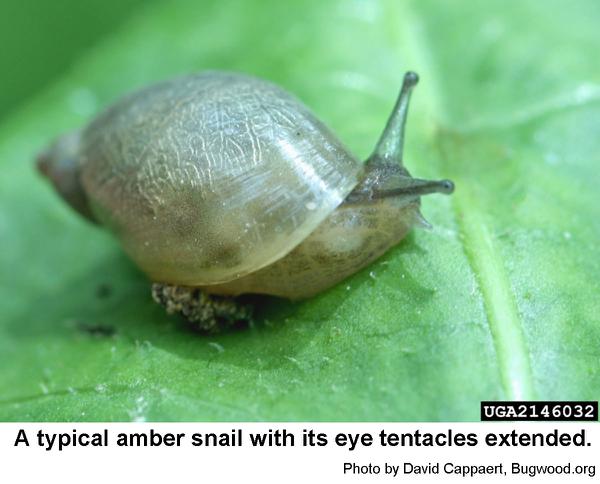Description and Biology
Snails in the family Succineidae are relatively primitive, air breathing, land snails that have very thin shells. We have about twenty species in the eastern United States. These snails are called amber snails because the shell is translucent and often amber in color. These snails tend to be small (less than 3/4 inch long). They have two pairs of tentacles, the upper ones of which are stalked eyes that can be withdrawn into the body. Amber snails are usually associated with stream banks, ponds, lakes or marshes. The shell's "spire" is unusually short compared to the aperture through which the snail can partially withdraw into the shell. This opening is sometimes half to two thirds as wide as the rest of the shell. There is no lip around the aperture. Young amber snails are male whereas older snails become female. As "adolescents," self fertilization may occur. Amber snail mate during the growing season and lay transparent eggs in batches on stones, soil, and water plants. Tiny, new snails hatch in about two weeks. They mature in about a year. Amber snails can tolerate dry periods of five to ten days by estivating (going dormant). Conversely, they can survive at least 36 hours under water.
Host Plants
These snails feed on plants, bacteria, fungi, algae, and diatoms that occur near ponds, lakes, and streams in association with monkeyflower, watercress, sedges and rushes. They have also been reported from euonymus, hibiscus, and New Zealand flax.
Residential Recommendations
Ordinarily, amber snails are not considered to be plant pests. Rain can encourage these snails. Metaldehyde is one pesticide to consider. The research with snail baits indicates that "Deadline" is the resistant to weathering away. Most garden centers and plant shops should carry "Deadline" or some other formulation of metaldehyde. Slug and snail baits that contain carbaryl (Sevin) or some other carbamate are more toxic to molluscs when the snails or slugs can get to water after treatment. Baits containing iron phosphate are also effective and can be water resistant, a plus for trying to control amber snails.
References
- Amber snails. Anonymous. 2017. California's Pest Snail and Slugs. Division of Agriculture and Natural Resources, University of California.
- Kanab Ambersnail (sic). Anonymous. 2017 (update). Grand Canyon, National Park Service.
- Amber Snails (Succineidae). Anonymous. No Date. The Living World of Molluscs.
- Oval Amber Snail, Succinea ovalis. Anonymous. No Date. Encyclopedia of Life. University of Michigan (?).
- NC State Extension Plant Pathology Publications
- NC State Extension Horticultural Science Publications
- North Carolina Agricultural Chemicals Manual
For assistance with a specific problem, contact your local Cooperative Extension center.
Publication date: Aug. 10, 2017
Reviewed/Revised: May 21, 2022
Recommendations for the use of agricultural chemicals are included in this publication as a convenience to the reader. The use of brand names and any mention or listing of commercial products or services in this publication does not imply endorsement by NC State University or N.C. A&T State University nor discrimination against similar products or services not mentioned. Individuals who use agricultural chemicals are responsible for ensuring that the intended use complies with current regulations and conforms to the product label. Be sure to obtain current information about usage regulations and examine a current product label before applying any chemical. For assistance, contact your local N.C. Cooperative Extension county center.
N.C. Cooperative Extension prohibits discrimination and harassment regardless of age, color, disability, family and marital status, gender identity, national origin, political beliefs, race, religion, sex (including pregnancy), sexual orientation and veteran status.

